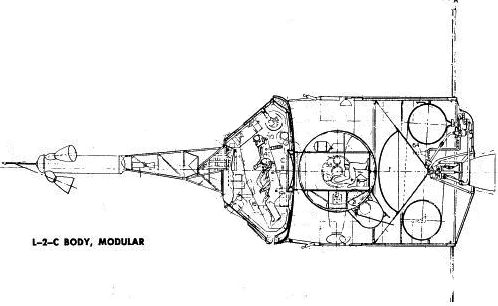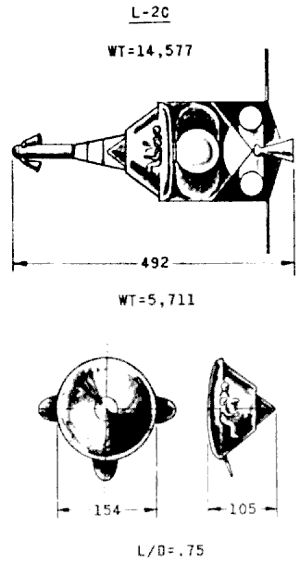
Home - Search - Browse - Alphabetic Index: 0- 1- 2- 3- 4- 5- 6- 7- 8- 9
A- B- C- D- E- F- G- H- I- J- K- L- M- N- O- P- Q- R- S- T- U- V- W- X- Y- Z
Apollo L-2C

Apollo L-2C
Status: Study 1962. Gross mass: 6,466 kg (14,255 lb). Height: 12.50 m (41.00 ft).
A jettisonable tower was equipped with a tractor-rocket launch escape system. Behind the flat aft bulkhead were propulsion, equipment, and mission modules. The circumlunar version had a total length of 12.5 m and a fuelled mass of 6,466 kg. Flaps provided limited maneuverability (hypersonic L/D ratio of 0.75) on re-entry, with a parachute landing system being used for final recovery.
Trade-offs between weight and propulsion requirements led to the selection of a pressurized shell of semi-monocoque aluminum alloy coated with a composite heat shield of super-alloy plus charring ablator. Two crewmen would sit abreast, with the third behind, in couches that could rotate for re-entry g-load protection and for getting in and out of the spacecraft. A jettisonable mission module (not used on the circumlunar version) could also serve as a solar storm cellar, a laboratory, or even the descent stage of a lunar lander.
Almost 300 persons in Martin spent the better part of the six months and about $3 million on the data and designs for their recommendations. Martin not only followed all the Space Task Group guidelines, but also went far beyond in systems analysis. Focusing on versatility, flexibility, safety margins, and growth, this was the only study that detailed the progression of steps from lunar orbiting to lunar landing. Later, when the hardware contract proposals were evaluated, Martin scored first on configuration design. In the final Apollo competition, Martin was rated highest and was initially told they would be awarded the contract. But a decision at the highest political levels resulted in North American being awarded the contract. After the Apollo 1 fire, North American hired key personnel from Martin to assist in defining the final Block II Apollo configuration.
Family: Manned spacecraft. Country: USA. Launch Vehicles: Saturn I, Saturn V. Agency: Martin.
 | Apollo L2C Credit: NASA |
Back to top of page
Home - Search - Browse - Alphabetic Index: 0- 1- 2- 3- 4- 5- 6- 7- 8- 9
A- B- C- D- E- F- G- H- I- J- K- L- M- N- O- P- Q- R- S- T- U- V- W- X- Y- Z
© 1997-2019 Mark Wade - Contact
© / Conditions for Use